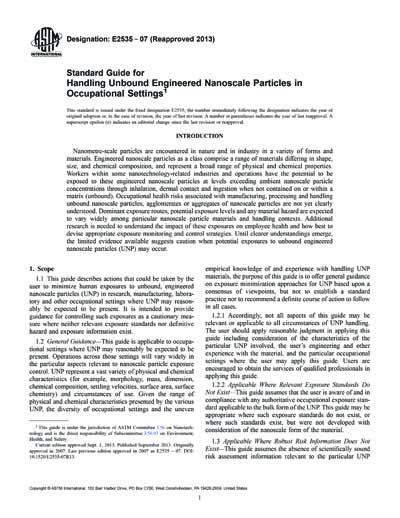Historical
ASTM E2535-07(2013)
Standard Guide for Handling Unbound Engineered Nanoscale Particles in Occupational Settings
1.1 This guide describes actions that could be taken by the user to minimize human exposures to unbound, engineered nanoscale particles (UNP) in research, manufacturing, laboratory and other occupational settings where UNP may reasonably be expected to be present. It is intended to provide guidance for controlling such exposures as a cautionary measure where neither relevant exposure standards nor definitive hazard and exposure information exist.
1.2 General Guidance—This guide is applicable to occupational settings where UNP may reasonably be expected to be present. Operations across those settings will vary widely in the particular aspects relevant to nanoscale particle exposure control. UNP represent a vast variety of physical and chemical characteristics (for example, morphology, mass, dimension, chemical composition, settling velocities, surface area, surface chemistry) and circumstances of use. Given the range of physical and chemical characteristics presented by the various UNP, the diversity of occupational settings and the uneven empirical knowledge of and experience with handling UNP materials, the purpose of this guide is to offer general guidance on exposure minimization approaches for UNP based upon a consensus of viewpoints, but not to establish a standard practice nor to recommend a definite course of action to follow in all cases.
1.2.1 Accordingly, not all aspects of this guide may be relevant or applicable to all circumstances of UNP handling. The user should apply reasonable judgment in applying this guide including consideration of the characteristics of the particular UNP involved, the user’s engineering and other experience with the material, and the particular occupational settings where the user may apply this guide. Users are encouraged to obtain the services of qualified professionals in applying this guide.
1.2.2 Applicable Where Relevant Exposure Standards Do Not Exist—This guide assumes that the user is aware of and in compliance with any authoritative occupational exposure standard applicable to the bulk form of the UNP. This guide may be appropriate where such exposure standards do not exist, or where such standards exist, but were not developed with consideration of the nanoscale form of the material.
1.3 Applicable Where Robust Risk Information Does Not Exist—This guide assumes the absence of scientifically sound risk assessment information relevant to the particular UNP involved. Where sound risk assessment information exists, or comes to exist, any exposure control measures should be designed based on that information, and not premised on this guide. Such measures may be more or less stringent than those suggested by this guide.
1.4 Materials Within Scope—This guide pertains to unbound engineered nanoscale particles or their respirable agglomerates or aggregates thereof. Relevant nanoscale particle types include, for example, intentionally produced fullerenes, nanotubes, nanowires, nanoropes, nanoribbons, quantum dots, nanoscale metal oxides, and other engineered nanoscale particles. Respirable particles are those having an aerodynamic equivalent diameter (AED) less than or equal to 10 µm (10 000 nm) or those particles small enough to be collected with a respirable sampler (1-3).2 The AED describes the behavior of an airborne particle and is dependent upon the particle density, shape, and size—for instance, a particle with a spherical shape, smooth surface, density of 1.0 g/cc and a physical diameter of 4 µm would have an AED of 4 µm, whereas a particle with a spherical shape, smooth surface, density of 11.35 g/cc and a physical diameter of 4 µm would have an AED of 14 µm and would therefore be of a nonrespirable size. Respirable fibers are those having physical diameters less than or equal to 3 µm (3000 nm) or those fibers small enough to be collected with a thoracic sampler (4, 5).
Content Provider
ASTM International [astm]






